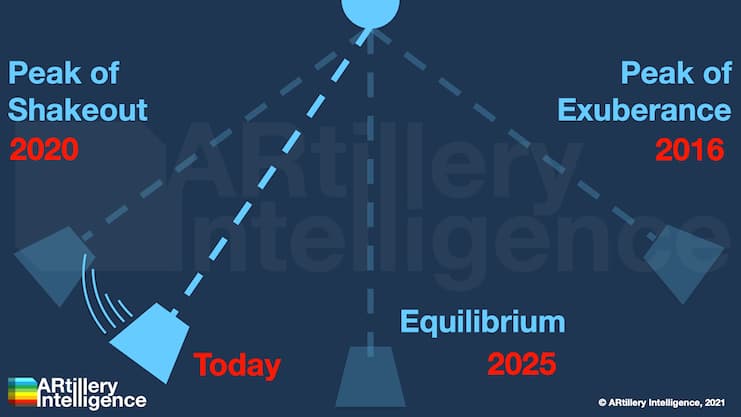
Spatial computing – including AR, VR, and other immersive tech – continues to alter the ways that we work, play, and live. But there have been ups and downs, characteristic of hype cycles. The pendulum has swung towards over-investment, then towards market correction.
That leaves us now in a sort of middle ground of reset expectations and moderate growth. Among XR subsectors, those seeing the most traction include AR brand marketing and consumer VR. Meta continues to advance the latter with massive investments and loss-leader pricing.
Beyond user-facing products, a spatial tech stack lies beneath. This involves a cast of supporting parts. We’re talking processing muscle (Qualcomm), experience creation (Adobe), and developer platforms (Snap). These picks and shovels are the engines of AR and VR growth.
So how is all of this coming together? Where are we in XR’s lifecycle? And where are there gaps in the value chain that signal opportunities? This is the topic of ARtillery Intelligence’s recent report Reality Check: the State of Spatial Computing, which we’ve excerpted below.
The Pendulum
When looking at spatial computing (AR and VR) the term hype cycle is often invoked. This is a useful way to contextualize where these technologies sit in their lifecycles. Often, there’s a period of over-investment, followed by market correction, then moderate growth.
Like a pendulum, these markets swung towards over-investment that peaked around 2016. Then, practical realities caught up with AR and VR… so they retracted. They swung toward market correction that peaked in 2020, after which a reborn industry grew at a more sober pace.
We’ve seen such cycles before – most notably, the dot com boom/bust. “Irrational exuberance” was followed by market retraction and scorched earth. Then, sprouting from those ashes were companies like Google and Facebook, and revolutions like social media and the smartphone.
That post-correction state is where we now sit in XR’s lifecycle. It’s not the revolution that was touted pre-2017, but it will create value in measured ways and in specific areas. Put another way, AR and VR may not revolutionize everything… but will evolve and elevate many things.

Hype & Hyperbole
As AR and VR continue to prove themselves in these ways, factors that do them a disservice include hype and hyperbole. In fact, after the circa-2016 period of elevated hype, many companies and investors got burned from believing that AR and VR’s revolutionary impact was imminent.
Consumers have also been turned off to some degree. That’s not because these technologies aren’t compelling, but because they’ve been disappointing relative to their hyped promises. Magic Leap’s first headset is one example of this sequence, and the company has paid for it.
With that backdrop, what’s the timeline for fully actualized AR and VR? For example, with AR, when will we get all-day AR glasses that offer both graphically robust UX and stylistic viability? That combination isn’t possible today due to technological realities and tradeoffs.
The consensus is that these goals will be reached in the 2030 timeframe. For example, Snap CEO Evan Spiegel has been realistic about this longer time horizon in his public statements. Meta CEO Mark Zuckerberg has also begun to publicly acknowledge this reality.
Short-Term Wins
Though the road to ubiquitous VR and “all-day” AR glasses’ is long and winding, there are meaningful wins along the way. For example, the above two tech leaders helm companies that are achieving such milestones, including user engagement and ad revenue for mobile AR viral lenses.
These short-term wins fuel their ability to speak honestly about the long term. They can temper expectations for AR glasses while armed with the confidence that the spatial computing work they’re doing today is producing tangible and financial – albeit gradual – results.
This framing makes AR’s 2030 deferment easier to swallow. The sooner we all come to terms with that – versus commentary that characterizes AR glasses’ and VR headsets’ world-changing impendence – the more we’ll set these technologies up to succeed through realistic expectations.
We’ll pause there and circle back in the next installment to go deeper into the state of XR and its many subsectors…

